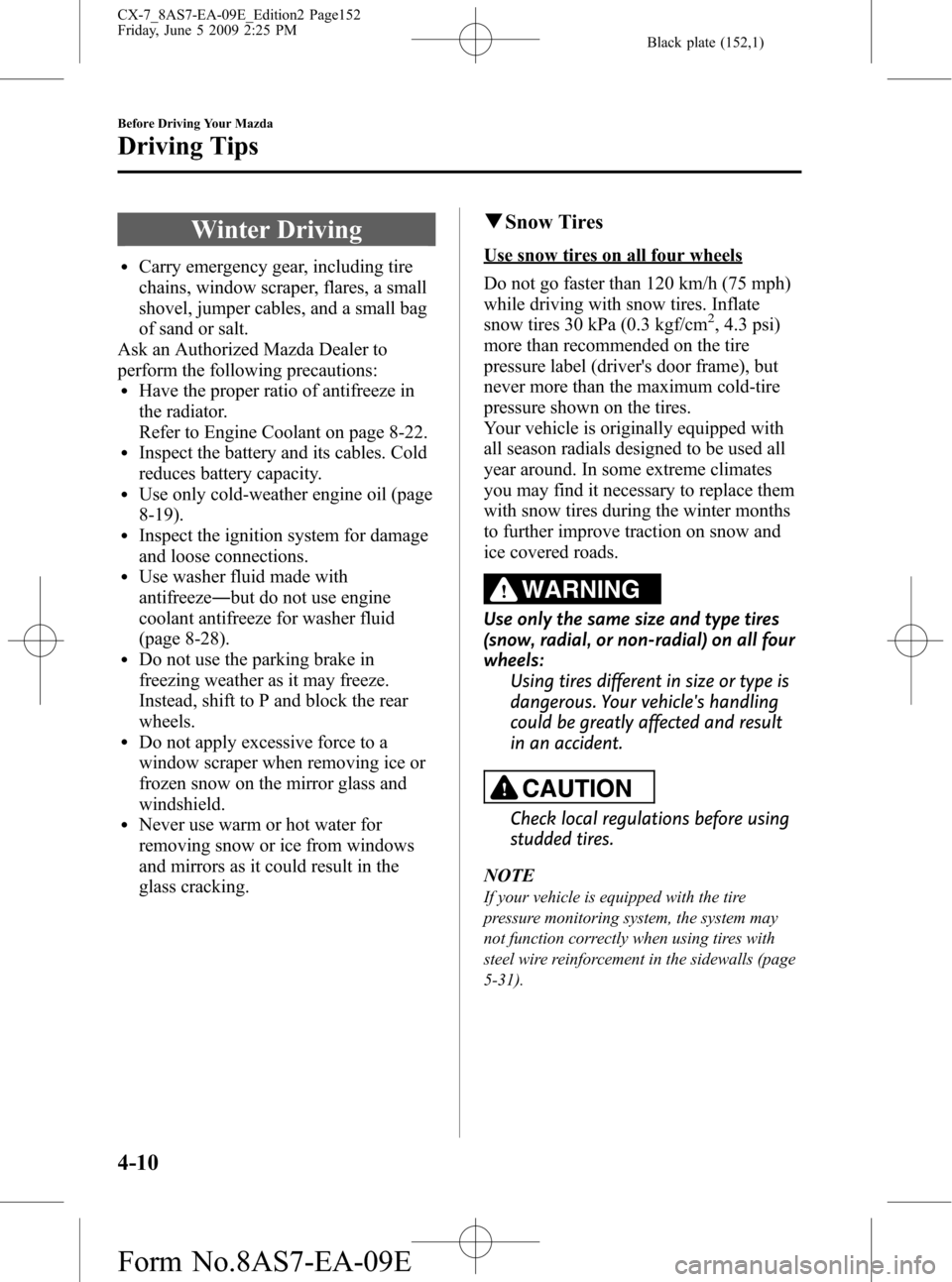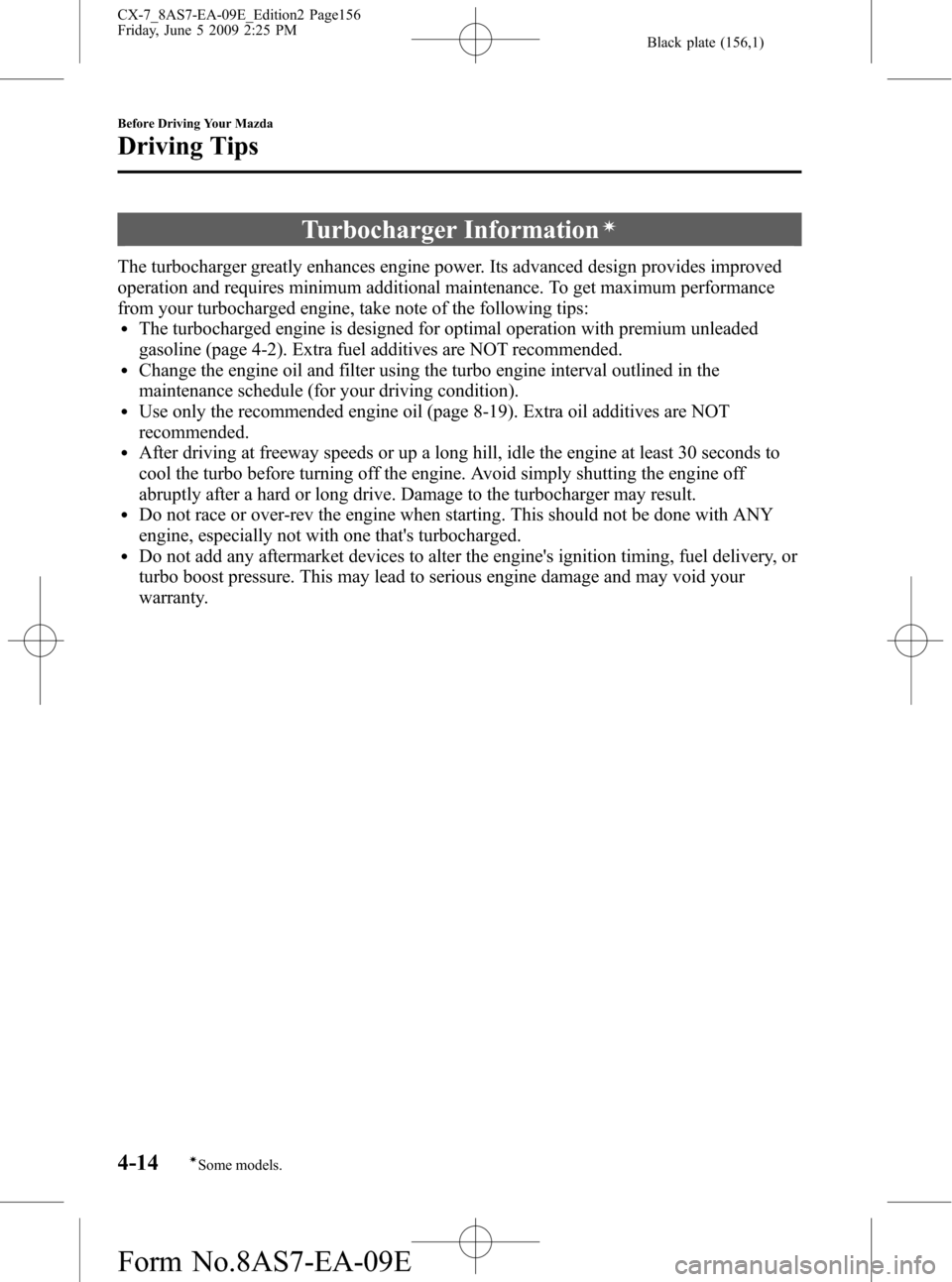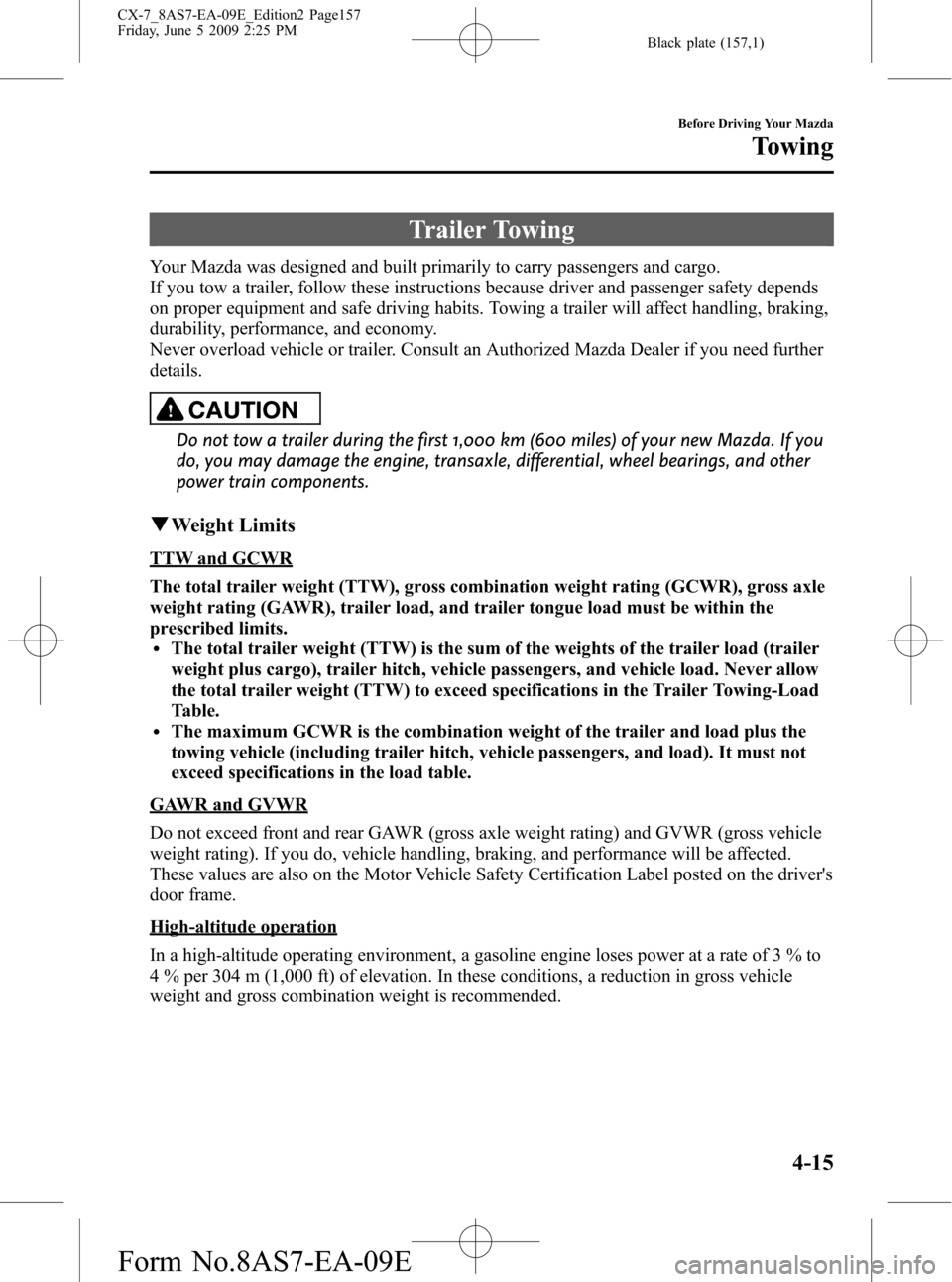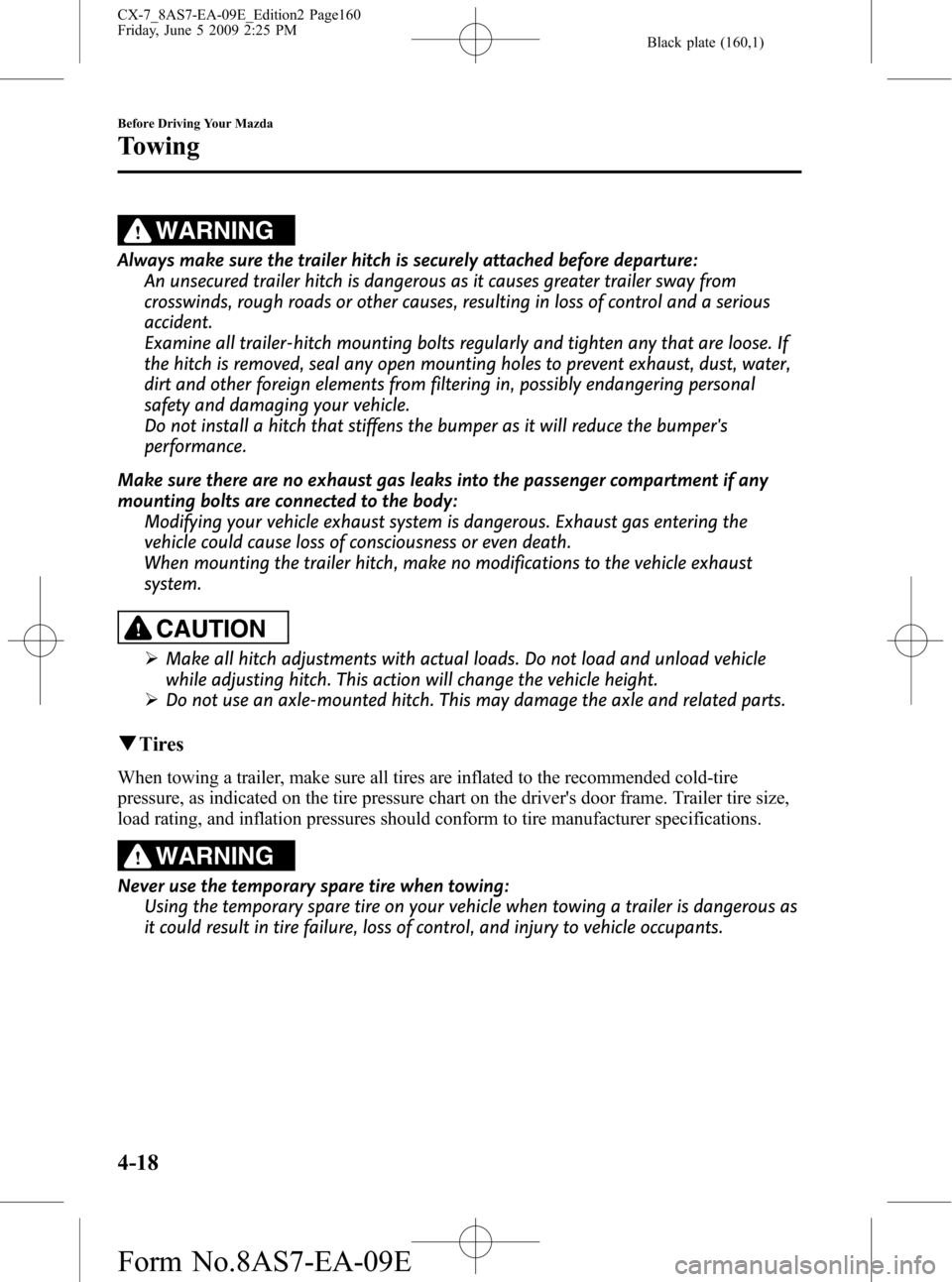MAZDA MODEL CX-7 2010 Owners Manual (in English)
Manufacturer: MAZDA, Model Year: 2010, Model line: MODEL CX-7, Model: MAZDA MODEL CX-7 2010Pages: 510, PDF Size: 8.55 MB
Page 151 of 510

Black plate (151,1)
Floor Mat
WARNING
Make sure the floor mats are hooked
on the retention pins to prevent them
from bunching up under the foot
pedals:
Using a floor mat that is not secured
is dangerous as it will interfere with
the accelerator and brake pedal
operation, which could result in an
accident.
Do not install two floor mats, one on
top of the other, on the driver's side:
Installing two floor mats, one on top
of the other, on the driver's side is
dangerous as the retention pins can
only keep one floor mat from sliding
forward.
In using a heavy duty floor mat for
winter use always remove the
original floor mat.
Loose floor mat(s) will interfere with
the foot pedal and could result in an
accident.
When setting a floor mat, position the
floor mat so that its eyelets are inserted
over the pointed end of the retention
posts.
Rocking the Vehicle
WARNING
Do not spin the wheels at more than 56
km/h (35 mph), and do not allow
anyone to stand behind a wheel when
pushing the vehicle:
When the vehicle is stuck, spinning
the wheels at high speed is
dangerous. The spinning tire could
overheat and explode. This could
cause serious injuries.
CAUTION
Too much rocking may cause engine
overheating, transaxle failure, and
tire damage.
If you must rock the vehicle to free it from
snow, sand or mud, depress the
accelerator slightly and slowly move the
shift lever from D to R.
Before Driving Your Mazda
Driving Tips
4-9
CX-7_8AS7-EA-09E_Edition2 Page151
Friday, June 5 2009 2:25 PM
Form No.8AS7-EA-09E
Page 152 of 510

Black plate (152,1)
Winter Driving
lCarry emergency gear, including tire
chains, window scraper, flares, a small
shovel, jumper cables, and a small bag
of sand or salt.
Ask an Authorized Mazda Dealer to
perform the following precautions:
lHave the proper ratio of antifreeze in
the radiator.
Refer to Engine Coolant on page 8-22.
lInspect the battery and its cables. Cold
reduces battery capacity.
lUse only cold-weather engine oil (page
8-19).
lInspect the ignition system for damage
and loose connections.
lUse washer fluid made with
antifreeze―but do not use engine
coolant antifreeze for washer fluid
(page 8-28).
lDo not use the parking brake in
freezing weather as it may freeze.
Instead, shift to P and block the rear
wheels.
lDo not apply excessive force to a
window scraper when removing ice or
frozen snow on the mirror glass and
windshield.
lNever use warm or hot water for
removing snow or ice from windows
and mirrors as it could result in the
glass cracking.
qSnow Tires
Use snow tires on all four wheels
Do not go faster than 120 km/h (75 mph)
while driving with snow tires. Inflate
snow tires 30 kPa (0.3 kgf/cm
2, 4.3 psi)
more than recommended on the tire
pressure label (driver's door frame), but
never more than the maximum cold-tire
pressure shown on the tires.
Your vehicle is originally equipped with
all season radials designed to be used all
year around. In some extreme climates
you may find it necessary to replace them
with snow tires during the winter months
to further improve traction on snow and
ice covered roads.
WARNING
Use only the same size and type tires
(snow, radial, or non-radial) on all four
wheels:
Using tires different in size or type is
dangerous. Your vehicle's handling
could be greatly affected and result
in an accident.
CAUTION
Check local regulations before using
studded tires.
NOTE
If your vehicle is equipped with the tire
pressure monitoring system, the system may
not function correctly when using tires with
steel wire reinforcement in the sidewalls (page
5-31).
4-10
Before Driving Your Mazda
Driving Tips
CX-7_8AS7-EA-09E_Edition2 Page152
Friday, June 5 2009 2:25 PM
Form No.8AS7-EA-09E
Page 153 of 510

Black plate (153,1)
qTire Chains
Check local regulations before using tire
chains.
CAUTION
ØChains may affect handling.
ØDo not go faster than 50 km/h (30
mph) or the chain manufacturer's
recommended limit, whichever is
lower.
ØDrive carefully and avoid bumps,
holes, and sharp turns.
ØAvoid locked-wheel braking.
ØDo not use chains on a temporary
spare tire; it may result in damage
to the vehicle and to the tire.
ØDo not use chains on roads that
are free of snow or ice. The tires
and chains could be damaged.
ØChains may scratch or chip
aluminum wheels.
NOTE
If your vehicle is equipped with the tire
pressure monitoring system, the system may
not function correctly when using tire chains.
Install the chains on the front tires.
Do not use chains on the rear tires.
Please consult an Authorized Mazda
Dealer.
Installing the chains
1. Secure the chains on the front tires as
tightly as possible. Always follow the
chain manufacturer's instructions.
2. Retighten the chains after driving 1/2
―1 km (1/4―1/2 mile).
Driving In Flooded Area
WARNING
Dry wet brakes by driving very slowly
and applying the brakes lightly until
brake performance returns to normal:
Driving with wet brakes is
dangerous. Increased stopping
distance or the vehicle pulling to one
side when braking could result in a
serious accident. Light braking will
indicate whether the brakes have
been affected.
CAUTION
Do not drive the vehicle on flooded
roads as it could cause short
circuiting of electrical/electronic
parts, or engine damage or stalling
from water absorption. If the vehicle
has been immersed in water, consult
an Authorized Mazda Dealer.
Before Driving Your Mazda
Driving Tips
4-11
CX-7_8AS7-EA-09E_Edition2 Page153
Friday, June 5 2009 2:25 PM
Form No.8AS7-EA-09E
Page 154 of 510

Black plate (154,1)
Overloading
WARNING
Be careful not to overload your vehicle:
The gross axle weight rating (GAWR)
and the gross vehicle weight rating
(GVWR) of your vehicle are on the
Motor Vehicle Safety Standard Label
on the driver's door frame. Exceeding
these ratings can cause an accident
or vehicle damage. You can estimate
the weight of your load by weighing
the items (or people) before putting
them in the vehicle.
4-12
Before Driving Your Mazda
Driving Tips
CX-7_8AS7-EA-09E_Edition2 Page154
Friday, June 5 2009 2:25 PM
Form No.8AS7-EA-09E
Page 155 of 510

Black plate (155,1)
Driving on Uneven Road
Your vehicle's suspension and underbody can be damaged if driven on rough/uneven roads
or over speed bumps at excessive speeds. Use care and reduce speed when traveling on
rough/uneven roads or over speed bumps.
Use care not to damage the vehicle's underbody, bumpers or muffler(s) when driving under
the following conditions:
lAscending or descending a slope with a sharp transition anglelAscending or descending a driveway or trailer ramp with a sharp transition angle
Your vehicle is equipped with low profile tires allowing class-leading performance and
handling. As a result, the sidewall of the tires are very thin and the tires and wheels can be
damaged if driven through potholes or on rough/uneven roads at excessive speeds. Use
care and reduce speed when traveling on rough/uneven roads or through potholes.
Before Driving Your Mazda
Driving Tips
4-13
CX-7_8AS7-EA-09E_Edition2 Page155
Friday, June 5 2009 2:25 PM
Form No.8AS7-EA-09E
Page 156 of 510

Black plate (156,1)
Turbocharger Informationí
The turbocharger greatly enhances engine power. Its advanced design provides improved
operation and requires minimum additional maintenance. To get maximum performance
from your turbocharged engine, take note of the following tips:
lThe turbocharged engine is designed for optimal operation with premium unleaded
gasoline (page 4-2). Extra fuel additives are NOT recommended.
lChange the engine oil and filter using the turbo engine interval outlined in the
maintenance schedule (for your driving condition).
lUse only the recommended engine oil (page 8-19). Extra oil additives are NOT
recommended.
lAfter driving at freeway speeds or up a long hill, idle the engine at least 30 seconds to
cool the turbo before turning off the engine. Avoid simply shutting the engine off
abruptly after a hard or long drive. Damage to the turbocharger may result.
lDo not race or over-rev the engine when starting. This should not be done with ANY
engine, especially not with one that's turbocharged.
lDo not add any aftermarket devices to alter the engine's ignition timing, fuel delivery, or
turbo boost pressure. This may lead to serious engine damage and may void your
warranty.
4-14
Before Driving Your Mazda
íSome models.
Driving Tips
CX-7_8AS7-EA-09E_Edition2 Page156
Friday, June 5 2009 2:25 PM
Form No.8AS7-EA-09E
Page 157 of 510

Black plate (157,1)
Trailer Towing
Your Mazda was designed and built primarily to carry passengers and cargo.
If you tow a trailer, follow these instructions because driver and passenger safety depends
on proper equipment and safe driving habits. Towing a trailer will affect handling, braking,
durability, performance, and economy.
Never overload vehicle or trailer. Consult an Authorized Mazda Dealer if you need further
details.
CAUTION
Do not tow a trailer during the first 1,000 km (600 miles) of your new Mazda. If you
do, you may damage the engine, transaxle, differential, wheel bearings, and other
power train components.
qWeight Limits
TTW and GCWR
The total trailer weight (TTW), gross combination weight rating (GCWR), gross axle
weight rating (GAWR), trailer load, and trailer tongue load must be within the
prescribed limits.
lThe total trailer weight (TTW) is the sum of the weights of the trailer load (trailer
weight plus cargo), trailer hitch, vehicle passengers, and vehicle load. Never allow
the total trailer weight (TTW) to exceed specifications in the Trailer Towing-Load
Table.
lThe maximum GCWR is the combination weight of the trailer and load plus the
towing vehicle (including trailer hitch, vehicle passengers, and load). It must not
exceed specifications in the load table.
GAWR and GVWR
Do not exceed front and rear GAWR (gross axle weight rating) and GVWR (gross vehicle
weight rating). If you do, vehicle handling, braking, and performance will be affected.
These values are also on the Motor Vehicle Safety Certification Label posted on the driver's
door frame.
High-altitude operation
In a high-altitude operating environment, a gasoline engine loses power at a rate of 3 % to
4 % per 304 m (1,000 ft) of elevation. In these conditions, a reduction in gross vehicle
weight and gross combination weight is recommended.
Before Driving Your Mazda
Towing
4-15
CX-7_8AS7-EA-09E_Edition2 Page157
Friday, June 5 2009 2:25 PM
Form No.8AS7-EA-09E
Page 158 of 510

Black plate (158,1)
TRAILER TOWING-LOAD TABLE
Because vehicle weights vary, adjustments must be made to meet the requirements in this
table.
ItemModel
2.3-liter engine2.5-liter
engine
2WD AWD 2WD
MAX.
FRONTAL
AREA
2.97 m2(32 ft2)
MAX. TTWAdd trailer's weight, load and hitch; vehicle
passengers and vehicle load
*
907 kg (2,000 lb)680 kg
(1,500 lb)
MAX. GCWR
2,815 kg
(6,206 lb)2,914 kg
(6,424 lb)2,526 kg
(5,569 lb)
MAX. GAWR
Front1,150 kg
(2,535 lb)1,189 kg
(2,621 lb)1,104 kg
(2,434 lb)
Rear1,022 kg
(2,253 lb)1,083 kg
(2,388 lb)1,025 kg
(2,260 lb)
MAX. GVWR
2,168 kg
(4,780 lb)2,267 kg
(4,998 lb)2,125 kg
(4,685 lb)
TRAILER-
TONGUE
LOADTongue load
Tongue load/Trailer load × 100 = 10 % to 15 %
Trailer load
DISTRIBU-
TION OF
TRAILER
LOADFront 60 %
Rear 40 %
* i.e. baggage, food, camp gear
GCWR: Gross Combination Weight Rating (sum of TTW, vehicle weights and 2
passengers)
GAWR: Gross Axle Weight Rating
GVWR: Gross Vehicle Weight Rating
4-16
Before Driving Your Mazda
Towing
CX-7_8AS7-EA-09E_Edition2 Page158
Friday, June 5 2009 2:25 PM
Form No.8AS7-EA-09E
Page 159 of 510

Black plate (159,1)
WARNING
Always keep tow loads within specified limits as indicated in the Trailer Towing-Load
Table:
Attempting to tow loads greater than those specified is dangerous as it may cause
serious handling and performance problems that could result in personal injury or
vehicle damage, or both.
Load your trailer with the weight about 60 % toward the front and 40 % toward the
rear:
Loading the trailer with more weight in the rear than in the front is dangerous.
Doing so could cause you to lose control. The trailer tongue load must be 10 %―15
% of the total trailer load (sum of the weights of the trailer and cargo).
Always have the total trailer weight and tongue load determined prior to departure:
Attempting to tow loads without determining the total trailer weight and tongue
load is dangerous. Trailer sway from crosswinds, rough roads or other causes could
result in loss of control and a serious accident.
CAUTION
The total trailer weight and tongue load can be determined by weighing the trailer
on platform scales at a highway weight station or a trucking company.
qTrailer Hitch
Use only a hitch ball recommended by the trailer manufacturer that conforms to the gross
trailer weight requirement.
When not towing a trailer, remove the trailer hitch (if detachable) to reduce the possibility
of damage as a result of the vehicle being rear-ended.
Before Driving Your Mazda
Towing
4-17
CX-7_8AS7-EA-09E_Edition2 Page159
Friday, June 5 2009 2:25 PM
Form No.8AS7-EA-09E
Page 160 of 510

Black plate (160,1)
WARNING
Always make sure the trailer hitch is securely attached before departure:
An unsecured trailer hitch is dangerous as it causes greater trailer sway from
crosswinds, rough roads or other causes, resulting in loss of control and a serious
accident.
Examine all trailer-hitch mounting bolts regularly and tighten any that are loose. If
the hitch is removed, seal any open mounting holes to prevent exhaust, dust, water,
dirt and other foreign elements from filtering in, possibly endangering personal
safety and damaging your vehicle.
Do not install a hitch that stiffens the bumper as it will reduce the bumper's
performance.
Make sure there are no exhaust gas leaks into the passenger compartment if any
mounting bolts are connected to the body:
Modifying your vehicle exhaust system is dangerous. Exhaust gas entering the
vehicle could cause loss of consciousness or even death.
When mounting the trailer hitch, make no modifications to the vehicle exhaust
system.
CAUTION
ØMake all hitch adjustments with actual loads. Do not load and unload vehicle
while adjusting hitch. This action will change the vehicle height.
ØDo not use an axle-mounted hitch. This may damage the axle and related parts.
qTires
When towing a trailer, make sure all tires are inflated to the recommended cold-tire
pressure, as indicated on the tire pressure chart on the driver's door frame. Trailer tire size,
load rating, and inflation pressures should conform to tire manufacturer specifications.
WARNING
Never use the temporary spare tire when towing:
Using the temporary spare tire on your vehicle when towing a trailer is dangerous as
it could result in tire failure, loss of control, and injury to vehicle occupants.
4-18
Before Driving Your Mazda
Towing
CX-7_8AS7-EA-09E_Edition2 Page160
Friday, June 5 2009 2:25 PM
Form No.8AS7-EA-09E